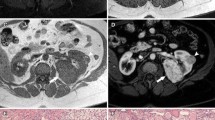Abstract
Renal cell carcinoma (RCC) is more common in men than women although the relationship between sex and histologic sub-type of RCC is unknown. The Columbia University Urologic Oncology Database of 1,105 patients who underwent nephrectomy from 1990–2005 was reviewed. 1,018 patients were included who underwent renal surgery with complete demographic data and post-operative pathologic information; 49 with incomplete information and 36 with “granular” histology were excluded. Differences in histology, size and volume of primary tumor, laterality, chief complaint, age, pathologic stage and status were evaluated by sex using ANOVA techniques. The cohort included 671 (66.1%) men and 344 (33.8%) women. There were no differences in age (61.0 vs. 60.7 years, P = 0.36), size (6.22 vs. 5.53 cm, P = 0.08) or volume (305 vs. 129cc, P = 0.07) of primary tumor. Men were more likely to have bilateral tumors (9.6 vs. 3.5%, P = 0.003). A greater percentage of men had malignant pathologic histology at nephrectomy (90.9 vs. 84.0%, P = 0.002). The rate of malignancy for women increased from 44.5% for tumors < 1 cm to 92.7% for tumors greater than 10 cm; there was no trend noted in men. Women had a greater percentage of conventional RCC (77.2 vs. 70.5%, P = 0.04). When analyzed by histologic sub-type, men were more likely to have papillary histology than women (17.4 vs. 4.5%), women were more likely to have chromophobe histology (11.2 vs. 5.0%; P = 0.006). Differences in demographics, pathologic parameters and histologic sub-typing are observed between men and women treated for renal masses.

Similar content being viewed by others
References
The American Cancer Society (2006) Cancer facts and figures. Atlanta, p 56
Campbell MF, Walsh PC (1998) Campbell's urology, 7th edn. W.B. Saunders Co., Philadelphia, pp 3 v (xli, 3432, lxxxix p)
Chow WH, Gridley G, Fraumeni JF Jr et al (2000) Obesity, hypertension, and the risk of kidney cancer in men. N Engl J Med 343:1305
Kovacs G, Akhtar M, Beckwith BJ et al (1997) The Heidelberg classification of renal cell tumours. J Pathol 183:131
Hruby G, Reisiger K, Venkatesh R et al (2006) Comparison of laparoscopic partial nephrectomy and laparoscopic cryoablation for renal hilar tumors. Urology 67:50
Lau WK, Cheville JC, Blute ML et al (2002) Prognostic features of pathologic stage T1 renal cell carcinoma after radical nephrectomy. Urology 59:532
Frank I, Blute ML, Cheville JC et al (2003) Solid renal tumors: an analysis of pathological features related to tumor size. J Urol 170:2217
Amin MB, Amin MB, Tamboli P et al (2002) Prognostic impact of histologic subtyping of adult renal epithelial neoplasms: an experience of 405 cases. Am J Surg Pathol 26:281
Mancilla-Jimenez R, Stanley RJ, Blath RA (1976) Papillary renal cell carcinoma: a clinical, radiologic, and pathologic study of 34 cases. Cancer 38:2469
Author information
Authors and Affiliations
Corresponding author
Rights and permissions
About this article
Cite this article
Pierorazio, P.M., Murphy, A.M., Benson, M.C. et al. Gender discrepancies in the diagnosis of renal cortical tumors. World J Urol 25, 81–85 (2007). https://doi.org/10.1007/s00345-006-0124-9
Published:
Issue Date:
DOI: https://doi.org/10.1007/s00345-006-0124-9




